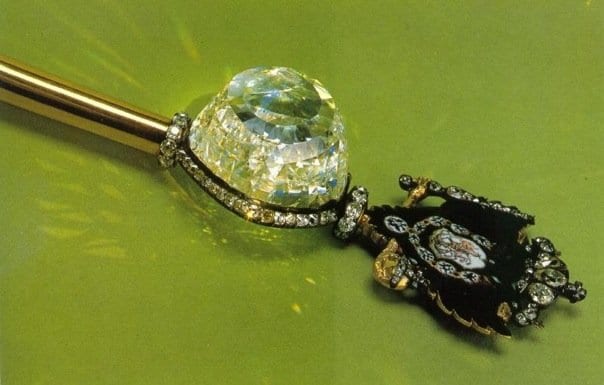Weight - 189.62 carats (37.924 g)
Measurement - 32 millimetres x 35 millimetres x 31 millimetres
Currently at - Diamond Fund of the Moscow Kremlin
Features - Color: slightly bluish green, Clarity: exceptionally pure, Cut: Mogul-cut rose
Source - India
The origin of this resplendent relic – described as having the shape and proportions of half a hen's egg – can be traced back to a Hindu temple in 18th century Tamil Nadu, southern India.
The particulars of the Orlov's story have been lost with time, but it is widely reported that the diamond once served as an eye of the statue of the presiding deity of the Sri Ranganathaswamy Temple of Srirangam in southern India. The man held responsible for its removal was a French deserter, a grenadier from the Carnatic wars who apparently converted to the Hindu faith and worshipped at the temple for many years. Whether the deserter did this sincerely or solely to gain access to the statue is not known. The temple, situated on an island in the Cauvery River, was surrounded by seven enclosures; no Christians were ever permitted farther than the fourth. Once having pilfered the stone from its sacred home around 1750, perhaps after untold years of patient planning, the deserter fled to Madras where he would find protection with the British Army, as well as a buyer.
Measurement - 32 millimetres x 35 millimetres x 31 millimetres
Currently at - Diamond Fund of the Moscow Kremlin
Features - Color: slightly bluish green, Clarity: exceptionally pure, Cut: Mogul-cut rose
Source - India
The origin of this resplendent relic – described as having the shape and proportions of half a hen's egg – can be traced back to a Hindu temple in 18th century Tamil Nadu, southern India.
The particulars of the Orlov's story have been lost with time, but it is widely reported that the diamond once served as an eye of the statue of the presiding deity of the Sri Ranganathaswamy Temple of Srirangam in southern India. The man held responsible for its removal was a French deserter, a grenadier from the Carnatic wars who apparently converted to the Hindu faith and worshipped at the temple for many years. Whether the deserter did this sincerely or solely to gain access to the statue is not known. The temple, situated on an island in the Cauvery River, was surrounded by seven enclosures; no Christians were ever permitted farther than the fourth. Once having pilfered the stone from its sacred home around 1750, perhaps after untold years of patient planning, the deserter fled to Madras where he would find protection with the British Army, as well as a buyer.

People who voted for this also voted for
LBD - Little Black Dress
Light festival in Ghent, Belgium
My cakes
Fantasy Art (part 6)
Beautiful Animals Lists?
Ariel
Captain America
Artist's Impressions of Space »1«
Movie Stars which I like
The People Behind The Mask
Gorgeous in the 40s
Thor
Autumn
(•̪●) Darkness (•̪●)
Fantasy Art (part 3)
 Login
Login














